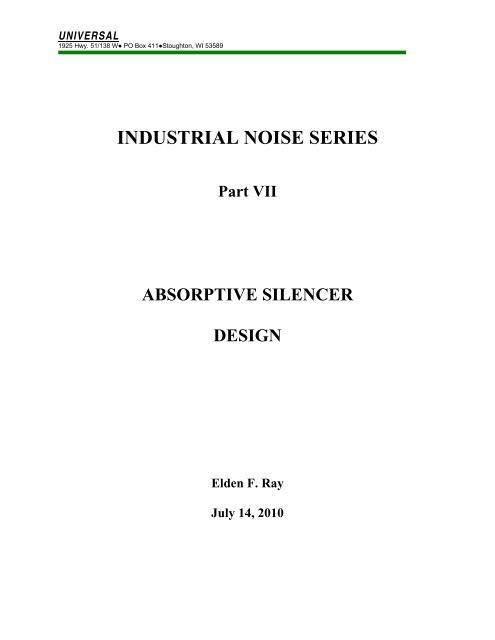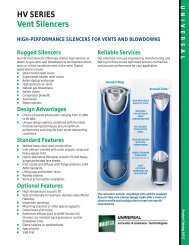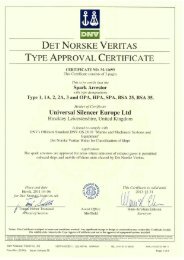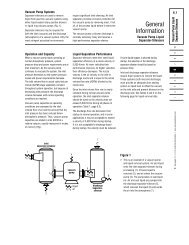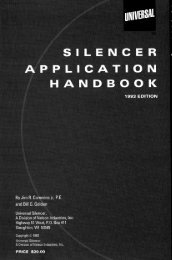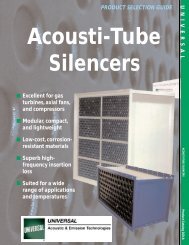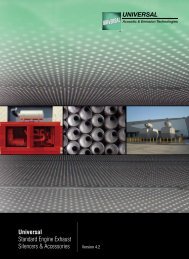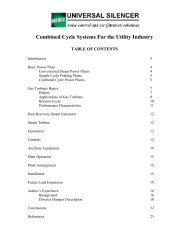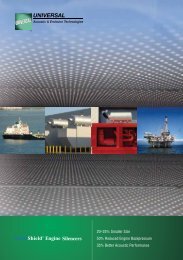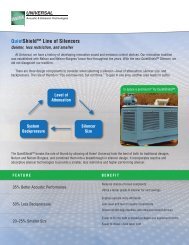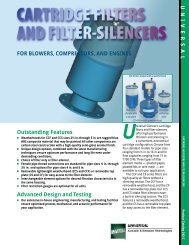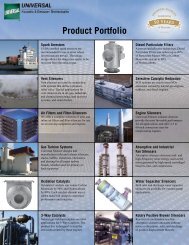Absorptive Silencer Design - Universal: Acoustic Silencers
Absorptive Silencer Design - Universal: Acoustic Silencers
Absorptive Silencer Design - Universal: Acoustic Silencers
You also want an ePaper? Increase the reach of your titles
YUMPU automatically turns print PDFs into web optimized ePapers that Google loves.
UNIVERSAL<br />
1925 Hwy. 51/138 W● PO Box 411●Stoughton, WI 53589<br />
INDUSTRIAL NOISE SERIES<br />
Part VII<br />
ABSORPTIVE SILENCER<br />
DESIGN<br />
Elden F. Ray<br />
July 14, 2010
UNIVERSAL<br />
1925 Hwy. 51/138 W● PO Box 411●Stoughton, WI 53589<br />
TABLE OF CONTENTS<br />
1. INTRODUCTION 1<br />
2. SILENCER PERFORMANCE 3<br />
3. FLOW RESISTANCE AND RESISTIVITY 5<br />
4. FLOW VELOCITY 6<br />
5. BAFFLE ATTENUATION EXAMPLE 6<br />
6. BAFFLE MODELING AND ANALYSIS 7<br />
7. SELF NOISE AND DYNAMIC INSERTION LOSS 8<br />
8. INSERTION LOSS 10<br />
9. TRANSMISSION LOSS 10<br />
10. PARAMETRIC EXAMPLES 12
UNIVERSAL<br />
1925 Hwy. 51/138 W● PO Box 411●Stoughton, WI 53589<br />
ABSORPTIVE SILENCER DESIGN<br />
1. INTRODUCTION<br />
The basics of absorptive silencer design and the fundamental approach in design of<br />
parallel baffle silencers is presented. The reduction of sound energy using absorptive materials<br />
is achieved by transferring the acoustical pressure (wave motion) into material motion. This<br />
mechanical motion is converted into heat (energy loss) by material damping and friction. The<br />
more effective the sound wave penetrates the material the more effective the attenuation. Each<br />
baffle assembly consists of “compartments” and the basic theory is each compartment is locally<br />
reacting where the acoustic sound wave “pumps in and out” though the material as well as<br />
through the perforated facing sheet or pack material retainer. The perforation pattern adds<br />
damping and frictional losses to the aero-acoustic wave oscillating through the holes; the smaller<br />
the holes and more perforations, the more attenuation. The packing consists of absorptive<br />
material that is principally fibrous materials or open cell foams that allow the wave energy to<br />
penetrate, induce material motion, and be attenuated.<br />
The wavelength of sound is a major factor in sound reduction as well since the absorptive<br />
material only starts to become effective when its thickness is at least one-tenth the wavelength so<br />
obviously, very low frequencies are not well attenuated. The effective depth of a baffle is onehalf<br />
its thickness as acoustic energy is propagating into the baffle from both sides. Baffle<br />
geometry is described in the following figure and the descriptors vary between resources.<br />
<strong>Silencer</strong>s were developed based on this geometry and the corresponding open area ratio (OAR)<br />
of the baffles in the silencer duct. The open area is the area available for gas or air flow through<br />
the silencer.<br />
d<br />
2h<br />
2d<br />
Effective Length, L<br />
FIGURE 1. BAFFLE GEOMETRY<br />
<strong>Silencer</strong> - Baffle OAR% = 100 x 2h/(2h + 2d) = 100 x h/(h + d)<br />
- 1 -
UNIVERSAL<br />
1925 Hwy. 51/138 W● PO Box 411●Stoughton, WI 53589<br />
Full air gap = 2h, Baffle thickness = 2d<br />
Note that half gaps and half baffle thickness are h and d respectively and performance is<br />
based on these parameters permitting the use of half baffles and half gaps in silencer<br />
applications. Each configuration in the following series of figures has the identical acoustical<br />
performance and OAR to that of Figure 1 assuming the dimensions d, h and L are identical.<br />
h<br />
2d<br />
h<br />
Effective Length, L<br />
d<br />
2h<br />
Effective Length, L<br />
d<br />
Effective Length, L<br />
d<br />
h<br />
FIGURE 2. BAFFLE GEOMETRIES HAVING IDENTICAL ACOUSTICAL PERFORMANCE<br />
The number of baffles and air gaps only affects flow area as does the height or span of<br />
the baffle; more baffles, more flow area, lower air gap velocity, lower pressure loss. The number<br />
of parallel baffles does not affect the acoustical performance whatsoever except in the case of<br />
self flow noise; a function of the gas or air velocity between the baffles and face area of the<br />
baffles. The face area is the total cross sectional area of the silencer occupied by baffles.<br />
There are two basic parallel baffle arrangements. The familiar flat, rectangular parallel<br />
baffles and the annular ring baffle used in cylindrical silencers. In general, the method used for<br />
- 2 -
UNIVERSAL<br />
1925 Hwy. 51/138 W● PO Box 411●Stoughton, WI 53589<br />
calculating flat panel baffles can be used for annular silencers but there is some performance<br />
departure about the 2,000-3,000 Hz region that may cause a slight drop in performance and in<br />
other geometries the performance improves. The reason for using flat parallel baffle approach is<br />
cylindrical databases are not widely published and those that are only provide data in a limited<br />
range. A safety margin will cover these issues.<br />
Key parameters that are used for baffle design are the dimensions cited above, the airflow<br />
resistivity of the pack material (rayls/m), the airflow resistance (rayls) of any thin layer retainer<br />
materials. More sophisticated analyses include the thickness and areal density of the perforated<br />
face sheet, perforation diameter and oar, the density of the pack material, and its material<br />
properties. These latter parameters are frequently missing from standard “lookup curves.”<br />
2. SILENCER PERFORMANCE<br />
The challenge in baffle design is determining the attenuation in a grazing flow<br />
environment; that is, the sound travels parallel to the surface (grazing) thus interaction of the<br />
sound wave with the baffle is not optimal at all. The direction of flow with respect to the<br />
direction of the sound wave also affects performance in that for an identical baffle and sound<br />
energy, the performance will be different for a positive traveling wave versus a negative<br />
traveling wave. The following figure illustrates the flow regimes; the curves represent the sound<br />
energy.<br />
Air Flow<br />
FIGURE 3A. POSITIVE FLOW CASE – SOUND AND FLOW ARE TRAVELING DOWNSTREAM; THIS<br />
IS COMMONLY KNOWN AS EXHAUST OR SUPPLY FLOW.<br />
Air Flow<br />
FIGURE 3B. NEGATIVE FLOW CASE – SOUND TRAVELS UPSTREAM AND FLOW TRAVELS<br />
DOWNSTREAM; THIS IS COMMONLY KNOWN AS INLET OR RETURN FLOW.<br />
- 3 -
UNIVERSAL<br />
1925 Hwy. 51/138 W● PO Box 411●Stoughton, WI 53589<br />
Calculating silencer performance was not developed when ventilation equipment started<br />
being installed in buildings and the only method was to build and test silencers. Later, the<br />
HVAC 1 industry developed standardized testing protocols to measure silencer performance. The<br />
national standard is ASTM E 477, Standard Test Method for Measuring <strong>Acoustic</strong>al and Airflow<br />
Performance of Duct Liner Materials and Prefabricated <strong>Silencer</strong>s. The ISO standard is, ISO<br />
7235 <strong>Acoustic</strong>s – Laboratory measurement procedures for ducted silencers and air-terminal<br />
units – Insertion loss, flow noise and total pressure loss. Also, there is a standard for measuring<br />
silencer performance in-situ or for very large silencers that cannot be measured in a laboratory; it<br />
is ISO 11820 <strong>Acoustic</strong>s – Measurements on silencers in situ. It provides guidelines for<br />
measuring both insertion loss (IL) and transmission loss (TL).<br />
Although computational capabilities now exist, the complexity of the silencer required a<br />
significant amount of analysis that naturally had some uncertainty regarding performance thus<br />
most all HVAC silencer manufacturers just tested their products and cataloged them for easy<br />
selection. With over 50 years of testing, databases (performance curves based on OAR) have<br />
been developed. Figure 4 (Fig. 10.20 from Beranek and Ver) 2 shows normalized attenuation<br />
performance for a 66% open area silencer based on four acoustical materials under no-flow<br />
(static) conditions. The four materials have normalized flow resistances of 1, 2, 5 and 10.<br />
FIGURE 4. NORMALIZED ATTENUATION VERSUS FREQUENCY FOR PARALLEL BAFFLES<br />
1 Heating, Ventilation and Air Conditioning (HVAC)<br />
2 A.G. Galaitsis and I.L. Ver, “Passive <strong>Silencer</strong>s and Lined Ducts,” Ch 10 in Noise and Vibration Control<br />
Engineering Principles and Applications, edited by Beranek, L.L. & Ver, I.L. (John Wiley & Sons Inc. NY 1992)<br />
- 4 -
UNIVERSAL<br />
1925 Hwy. 51/138 W● PO Box 411●Stoughton, WI 53589<br />
The abscissa is the full air gap (2h) divided by the wavelength (c/f). The ordinate shows<br />
the attenuation rate, L h in decibels per half gap (h); the baffle attenuation is L h multiplied by<br />
(L/h). Some resources show the attenuation rate per full gap (2h) so the ordinate values would be<br />
half that shown; so be careful when comparing databases. And also note, terminology and<br />
symbols may vary between resources.<br />
Parallel baffle performance is contingent upon the open area of the baffle arrangement<br />
(OAR) and a unique performance curve for each open area is required; thus, a family of curves<br />
covering 25%, 33%, 40%, 50%, and 66% are common in any design and analysis library and<br />
each family of curves will include performances based on the pack material’s flow resistivity. If<br />
a baffle arrangement has some other OAR then the result is obtained by interpolation.<br />
What is not shown in these normalized graphs is the perforated face sheet of the baffle.<br />
The open area of the perforated face sheet also affects performance; particularly above 1,000 Hz.<br />
Most all HVAC silencers use 40% open area thus it is seldom an issue in terms of application but<br />
for industrial applications where low percentage perforated sheeting may be used it does become<br />
important. In general, for typical engine applications 23% is acceptable but in the case of turbine<br />
exhausts that have high frequency content, then 32-35% should be considered. For turbine<br />
inlets, high speed fans, and any devices that have significant tones above 1,000 Hz, use 40% as a<br />
minimum. The open area ratio (OAR) in percent of perforated sheeting may be calculated by,<br />
Square perforation pattern: P% = 78.5(d/b) 2 (1)<br />
Hex perforation pattern: P% = 90.7(d/b) 2 (2)<br />
Where d is the diameter of the hole and b is the center to center spacing of the holes.<br />
3. FLOW RESISTANCE AND RESISTIVITY<br />
Flow resistance or resistivity is a measure of the material’s resistance to penetration by a<br />
sound wave; the lower the number the easier it is for penetration and better attenuation. Very<br />
low flow resistivity is good for high frequencies and very high flow resistivity is good for low<br />
frequencies so there are trade-offs. ASTM C 522, Standard Test Method for Airflow Resistance<br />
of <strong>Acoustic</strong>al Materials is the method used for performing the measurements. Very thin<br />
materials such as fill retainers (screens, cloth and needle-mats) are measured for their total<br />
resistance in rayls and thicker packing materials are measured for their flow resistivity in<br />
rayls/meter. The rayl in this application is an aerodynamic measure of the pressure differential<br />
across the material at a known volumetric air velocity. Although not a true acoustical<br />
measurement, it is used for rating the packing material. Testing occurs in a duct with a known<br />
cross area so the parameters for rayls/m are composed of the following units, Pa·s/m 2 but Pa is<br />
N/m 2 so you may encounter, N·s/m 4 .<br />
In Figure 4 there are several curves showing flow resistivity. Note that the peak<br />
attenuation occurs where η is near unity when the air gap (2h) is equal to a wavelength. The<br />
- 5 -
UNIVERSAL<br />
1925 Hwy. 51/138 W● PO Box 411●Stoughton, WI 53589<br />
curves shown on these types of figures are the normalized flow resistance of the material and<br />
dependent upon the thickness d. By selecting a particular or desired performance curve (R in<br />
Figure 4) and knowing the baffle thickness (d) the flow resistivity (R l ) of the needed material is<br />
then determined by employing the following equation,<br />
R = R l d/ρc dimensionless (3)<br />
where ρc is the acoustical impedance of the air, 415 rayls. The units of R l are rayls/meter or<br />
rayls/inch. It is very important to note that the flow resistance will change with the operating<br />
temperature (T) because of the change in the gas or air viscosity. It may be scaled by,<br />
R(T) = R 0 (T/T 0 ) 1.2 dimensionless (4)<br />
R 0 = R l d/ρ 0 c 0 dimensionless (5)<br />
T is the absolute temperature in Kelvin (273° + °C) and Equation (5) represents the<br />
measured laboratory flow resistance at ambient or laboratory temperature, T 0 .<br />
4. FLOW VELOCITY<br />
The flow through baffles also affects the attenuation and longevity of the packing:<br />
• The flow velocity in any application should never exceed Mach 0.3 (0.3 x speed<br />
of sound) because the gas or air will begin to compress changing its properties.<br />
• The velocity between the baffles produces self noise that can limit the attenuation<br />
of a silencer thus the velocity should not exceed Mach 0.1 as a general rule.<br />
• The flow affects the sound energy interaction with the baffle by either making the<br />
acoustic interaction either shorter or longer based on the velocity and direction of<br />
noise relative to the flow. Downstream and upstream flow cases are shown in<br />
Figure 3. Flow is either positive or negative and is important in analyzing<br />
performance.<br />
• If calculating baffle performance, by using published curves (at no flow), the<br />
attenuation rate is adjusted by (Bies & Hansen, Eq. (9.79) 3 ,<br />
D M = D 0 [1 – 1.5M + M 2 ] (6)<br />
Where, D 0 is the attenuation rate (without flow) and -0.3 < M < 0.3 where M is<br />
the Mach number of the velocity between the baffles. Be sure to use the correct<br />
sign (+/-) of the Mach number depending on the flow case (Figure 3). Some<br />
3 Bies and Hansen, Engineering Noise Control, Theory and Practice, 2 nd edition, © David A. Bies and Colin H.<br />
Hanson, 1996<br />
- 6 -
UNIVERSAL<br />
1925 Hwy. 51/138 W● PO Box 411●Stoughton, WI 53589<br />
resources use different approaches for adjusting for self noise but this is most<br />
conservative and easy to use.<br />
5. BAFFLE ATTENUATION EXAMPLE<br />
An example calculation of baffle performance is given here, presenting only six middle<br />
bands. Assume a baffle configuration is 8 inches thick (2d) separated by 6 inches air gap (2h)<br />
that is 4 feet long (43% OAR). The air temperature is 68° F with a positive velocity of 100 fps<br />
through the baffles. For convenience of using Figure 5, the packing material’s flow resistivity,<br />
R l is 20,000 rayls/m; this has a normalized value close to “5” for d = 4 inches (0.1016 m). The<br />
results are given in the following table as explained below:<br />
Table 1 – Example Calculation of Baffle Attenuation<br />
Freq = 125 250 500 1000 2000 4000<br />
η = 0.11 0.22 0.44 0.89 1.77 3.55<br />
L h = 0.2 0.6 1.5 2.8 1.4 0.2<br />
D M = .175 .525 1.31 2.45 1.22 .175<br />
4 ft = 2.8 8.4 21.0 39.0 19.5 2.8<br />
Step 1 – Calculate η (2hf/c) for each band or frequency for the air gap of 6 inches.<br />
Step 2 – Go to Figure 4 and at each value of η across the abscissa go up and<br />
intersect the R=5 curve (solid line).<br />
Step 3 – Then traverse over to the ordinate and record the L h value.<br />
Step 4 – Calculate the gap velocity and its Mach number (note sign for flow case),<br />
M = 100/1126 = +0.088<br />
Step 5 – Calculate D M using Equation (6); here, D 0 = L h<br />
The flow effect reduces the attenuation about 12%, D M = L h x 0.8747<br />
Step 6 – The number of diameters of the gas path is 48/3 = 16;<br />
Step 7 – Multiply D M by 16 to obtain the attenuation in decibels for the 4 feet of baffle.<br />
Using this method one can calculate the required baffle length to achieve the attenuation<br />
needed or determine the flow resistivity of the packing material to be used. Now, HVAC catalog<br />
data would show higher attenuation rates because measured data is used versus calculated. Had<br />
another material been used (R), one would interpolate between the curves. For a different<br />
temperature, calculate R(T) using Equation (4) and adjust c (speed of sound accordingly).<br />
One could include many more frequencies in the calculations, which is easy with a<br />
spreadsheet with imbedded algorithms. Final baffle attenuation is further adjusted to account for<br />
baffle entrance and exit losses which are usually small. Keep in mind that virtually all text book<br />
and similar databases are generally conservative.<br />
6. BAFFLE – SILENCER MODELING<br />
- 7 -
UNIVERSAL<br />
1925 Hwy. 51/138 W● PO Box 411●Stoughton, WI 53589<br />
Fortunately, the need to use graphical databases to perform lengthy calculation to size a<br />
silencer is no longer required. Just imagine the design challenges for all the different flow<br />
conditions, temperatures, configurations, applications, and materials. There are software<br />
packages available for sizing baffles and silencers that have the capability to rapidly develop<br />
silencers for a wide range of configurations and materials. Some specialized programs include<br />
the density and dynamic properties of the pack material in determining performance. These<br />
programs permit the rapid design and optimization of silencers.<br />
7. SELF NOISE AND DYNAMIC INSERTION LOSS<br />
When air or gas flows through a baffle or silencer, the interaction of the fluid flow,<br />
particularly at the exit, causes flow disturbances resulting in flow noise. As the velocity<br />
increases the flow noise increases and there are no simple algorithms to calculate this affect as<br />
the geometry of the baffles and silencers are highly variable. Most published algorithms are<br />
fairly conservative and only a few include temperature affects. The baffle design spreadsheet<br />
used at <strong>Universal</strong> employs octave band algorithms for inlet and exhaust cases developed from<br />
self noise levels published in silencer catalogs and includes the temperature of the exhaust gas.<br />
An algorithm that incorporates temperature (other than ambient) for inlet silencers has not been<br />
developed yet. The interested reader can review this in detail by going to the acoustical<br />
spreadsheet user guide.<br />
When low noise requirements are specified the self noise may limit performance. Self<br />
noise is generally a sound power level adjustment to the resulting attenuated sound power level<br />
(PWL). An example calculation is presented in the following table. The final emitted PWL2 is<br />
the logarithmic summation of the previous two rows, PWL1 and the Self Noise PWL.<br />
Table 2 – Example of Self Noise on Performance, decibels (dB)<br />
OBCF: 31.5 63 125 250 500 1k 2k 4k 8k A-wt<br />
Source PWL 126 124 130 131 123 124 123 122 122 131<br />
<strong>Silencer</strong> TL 3 6 14 27 41 59 53 34 13<br />
PWL1 123 118 116 104 82 65 70 88 109 109<br />
Self Noise 91 83 74 71 69 67 71 69 63 76<br />
PWL2 123 118 116 104 82 69 74 88 109 109<br />
Delta = +4 +4<br />
DIL = 3 6 14 27 41 55 49 34 13 22<br />
In this example the velocity between the baffles is 164 ft/s (9855 fpm, 50 m/s) and causes<br />
degraded performance in the 1k and 2k octave bands by 4 dB (compare PWL1 to PWL2). As<br />
can be seen, this reduces the effective insertion loss in those bands resulting in what is termed<br />
the dynamic insertion loss (DIL) since it includes the affect of flow noise.<br />
Flow noise generally affects the middle bands and for very low noise requirements can be<br />
problematic resulting in large silencers to obtain a low velocity and with the added benefit of low<br />
pressure drop. However, the self noise is a power level that is also a function of the face area of<br />
- 8 -
UNIVERSAL<br />
1925 Hwy. 51/138 W● PO Box 411●Stoughton, WI 53589<br />
the silencer and as the silencer area increases to reduce velocity, there may be an increase in self<br />
noise PWL because of the area increase. PWLs are typically an absolute value and do not<br />
change but in the case of flow noise, the increase in area also causes more self noise energy to be<br />
present. This becomes very problematic in very low noise applications or if the power level of<br />
the source is very low as the self noise PWL can then be more than the source PWL.<br />
Very high or very low source sound power levels and the distribution of the energy<br />
across the bands will also impact the overall insertion loss performance. The following tables<br />
illustrate an example case; the only difference between the two tables is the sound power level<br />
(PWL) of the source listed in the second row. Table 3b lists sound power levels typical of large<br />
diesel engine exhausts and note that the overall sound power level is seven decibels less.<br />
Table 3a – Example of Source PWL on Overall Performance<br />
OBCF: 16 31.5 63 125 250 500 1k 2k 4k 8k A-wt<br />
Source PWL 112 116 122 124 124 137 142 146 141 134 149<br />
<strong>Silencer</strong> TL 1 1 2 4 7 10 16 29 17 6<br />
PWL1 111 115 120 120 117 127 126 117 124 128<br />
Self Noise 96 96 88 79 76 74 72 76 74 68<br />
PWL2 112 115 120 120 117 127 126 117 124 128 132<br />
DIL = 0 1 2 4 7 10 16 29 17 6 18<br />
Table 3b – Example of Source PWL on Overall Performance<br />
OBCF: 16 31.5 63 125 250 500 1k 2k 4k 8k A-wt<br />
Source PWL 136 154 156 151 138 136 135 133 133 131 142<br />
<strong>Silencer</strong> TL 1 1 2 4 7 10 16 29 17 6<br />
PWL1 135 153 154 147 131 126 119 104 116 125<br />
Self Noise 96 96 88 79 76 74 72 76 74 68<br />
PWL2 135 153 154 147 131 126 119 104 116 125 134<br />
DIL = 1 1 2 4 7 10 16 29 17 6 8<br />
Note the dramatic drop in overall A-weighted performance, from a DIL from 18 dB to 8<br />
dB even though the octave band level (16 Hz to 8k Hz) DIL is identical and the overall power<br />
level is seven decibels less, 142 dB versus 149 dB. In these cases, self noise was not a factor in<br />
performance.<br />
This example demonstrates the importance of having the sound power level of the source<br />
in order to assess the silencer performance.<br />
One element not addressed herein is pressure drop and is largely a function of the gap<br />
velocity. The calculation of acoustical performance must be balanced with pressure loss and the<br />
available area for the silencing system. In critical applications for high acoustical performance,<br />
low pressure loss, and limited size, the general rule is “pick any two.”<br />
- 9 -
UNIVERSAL<br />
1925 Hwy. 51/138 W● PO Box 411●Stoughton, WI 53589<br />
8. INSERTION LOSS<br />
Most times it is either insertion loss (IL) or dynamic insertion loss (DIL) specified as the<br />
performance requirement. It is critical to realize that the actual insertion loss is dependent upon<br />
the system duct geometry, the source’s sound power level, temperature of the fluid medium, and<br />
for dynamic insertion loss, the flow rate. Flow through a silencer generates self noise that may<br />
degrade performance and to meet a DIL means all the cited information above is required.<br />
One important item to know is insertion loss is the difference in sound pressure level at a<br />
set point with and without the silencer in place as illustrated below. This is not done as it is<br />
obvious that the expense of such a test would be prohibitive except for smaller silencers where a<br />
spool piece (empty duct section) could be easily inserted in place of the silencer.<br />
Sound<br />
Lp1<br />
Sound<br />
SILENCER<br />
Lp2<br />
FIGURE 2 – INSERTION LOSS MEASUREMENT<br />
DIL or IL = L P1 – L P2 dB (7)<br />
Obviously, to verify performance would be expensive by having the equipment and<br />
manpower to swap out the silencer for an empty duct section and make measurements.<br />
9. TRANSMISSION LOSS<br />
When specifying silencer performance, a more convenient method is to specify the<br />
transmission loss (TL) of the silencer. The TL is the reduction of sound power level and can be<br />
measured upstream and downstream of the silencer and the ducting system is not a factor. Refer<br />
to ISO 11820 <strong>Acoustic</strong>s – Measurements on silencers in situ; it provides guidelines for<br />
measuring both insertion loss (IL) and transmission loss (TL). <strong>Universal</strong> calculates the TL (as<br />
shown in Tables 2 and 3) and includes self noise, thus effectively showing the dynamic<br />
transmission loss (DTL) reported as DIL as shown in the cited tables. The TL is used because it<br />
is very rare that a full system description is provided when a silencer is requested and frequently<br />
system arrangements change during project development. In the case of changing ducting<br />
system arrangements, a revised calculation of the insertion loss would be necessary and most<br />
projects do not perform this as it causes delays and added costs if the silencer needs to be<br />
modified.<br />
- 10 -
UNIVERSAL<br />
1925 Hwy. 51/138 W● PO Box 411●Stoughton, WI 53589<br />
The following exercise demonstrates that TL is a very good approximation of IL. We<br />
start with the classical approach of measuring or defining the sound levels (L P ) with and without<br />
the silencer in place associated with insertion loss measurement. The sound power emitted from<br />
the duct is noted as L W1 and L W2 for the two measurement conditions.<br />
L P1 = L W1 + C dB (with the silencer)<br />
L P2 = L W2 + C dB (without silencer)<br />
IL = [L P2 – L P1 ] = [(L W2 + C) – (L W1 + C)] = L W2 – L W1 dB<br />
TL ≈ L W2 – L W1 dB<br />
(8a)<br />
(8b)<br />
(8c)<br />
(8d)<br />
Assuming C is constant for both boundary conditions, with and without the silencer, it is shown<br />
that the insertion loss (IL) is approximately equivalent to the TL. Now there are some liberties<br />
here as it assumes L W2 is the same value upstream of the silencer (in place). But lacking detailed<br />
design data, this is adequate to show that TL works well for estimating the IL of a system. The<br />
uncertainty is the very low frequencies which are generally not important for meeting an overall<br />
sound level reduction. When having to meet very low frequency TL or IL requirements, safety<br />
margin (increased silencing) is added to account for any uncertainty.<br />
- 11 -


